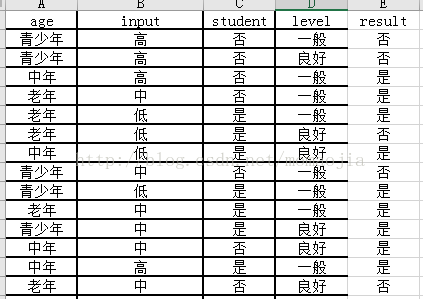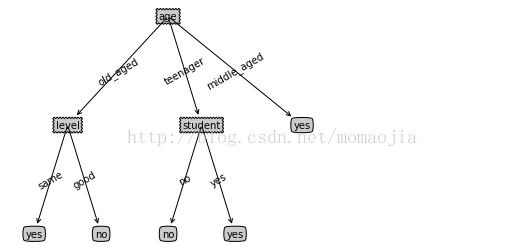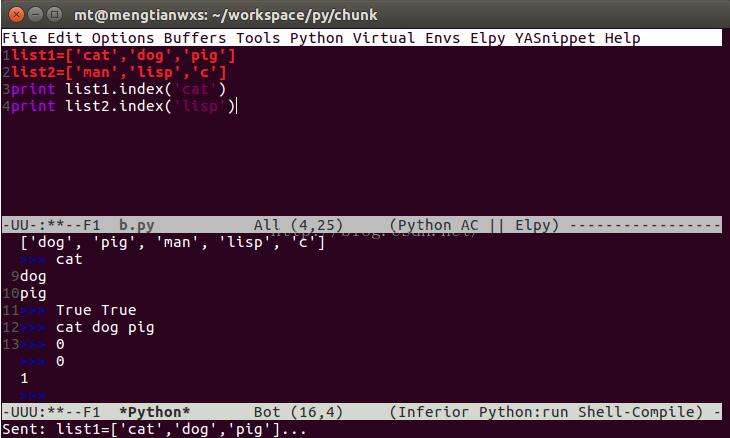python实现决策树分类
上一篇博客主要介绍了决策树的原理,这篇主要介绍他的实现,代码环境python 3.4,实现的是ID3算法,首先为了后面matplotlib的绘图方便,我把原来的中文数据集变成了英文。
原始数据集:

变化后的数据集在程序代码中体现,这就不截图了
构建决策树的代码如下:
#coding :utf-8
'''
2017.6.25 author :Erin
function: "decesion tree" ID3
'''
import numpy as np
import pandas as pd
from math import log
import operator
def load_data():
#data=np.array(data)
data=[['teenager' ,'high', 'no' ,'same', 'no'],
['teenager', 'high', 'no', 'good', 'no'],
['middle_aged' ,'high', 'no', 'same', 'yes'],
['old_aged', 'middle', 'no' ,'same', 'yes'],
['old_aged', 'low', 'yes', 'same' ,'yes'],
['old_aged', 'low', 'yes', 'good', 'no'],
['middle_aged', 'low' ,'yes' ,'good', 'yes'],
['teenager' ,'middle' ,'no', 'same', 'no'],
['teenager', 'low' ,'yes' ,'same', 'yes'],
['old_aged' ,'middle', 'yes', 'same', 'yes'],
['teenager' ,'middle', 'yes', 'good', 'yes'],
['middle_aged' ,'middle', 'no', 'good', 'yes'],
['middle_aged', 'high', 'yes', 'same', 'yes'],
['old_aged', 'middle', 'no' ,'good' ,'no']]
features=['age','input','student','level']
return data,features
def cal_entropy(dataSet):
'''
输入data ,表示带最后标签列的数据集
计算给定数据集总的信息熵
{'是': 9, '否': 5}
0.9402859586706309
'''
numEntries = len(dataSet)
labelCounts = {}
for featVec in dataSet:
label = featVec[-1]
if label not in labelCounts.keys():
labelCounts[label] = 0
labelCounts[label] += 1
entropy = 0.0
for key in labelCounts.keys():
p_i = float(labelCounts[key]/numEntries)
entropy -= p_i * log(p_i,2)#log(x,10)表示以10 为底的对数
return entropy
def split_data(data,feature_index,value):
'''
划分数据集
feature_index:用于划分特征的列数,例如“年龄”
value:划分后的属性值:例如“青少年”
'''
data_split=[]#划分后的数据集
for feature in data:
if feature[feature_index]==value:
reFeature=feature[:feature_index]
reFeature.extend(feature[feature_index+1:])
data_split.append(reFeature)
return data_split
def choose_best_to_split(data):
'''
根据每个特征的信息增益,选择最大的划分数据集的索引特征
'''
count_feature=len(data[0])-1#特征个数4
#print(count_feature)#4
entropy=cal_entropy(data)#原数据总的信息熵
#print(entropy)#0.9402859586706309
max_info_gain=0.0#信息增益最大
split_fea_index = -1#信息增益最大,对应的索引号
for i in range(count_feature):
feature_list=[fe_index[i] for fe_index in data]#获取该列所有特征值
#######################################
'''
print('feature_list')
['青少年', '青少年', '中年', '老年', '老年', '老年', '中年', '青少年', '青少年', '老年',
'青少年', '中年', '中年', '老年']
0.3467680694480959 #对应上篇博客中的公式 =(1)*5/14
0.3467680694480959
0.6935361388961918
'''
# print(feature_list)
unqval=set(feature_list)#去除重复
Pro_entropy=0.0#特征的熵
for value in unqval:#遍历改特征下的所有属性
sub_data=split_data(data,i,value)
pro=len(sub_data)/float(len(data))
Pro_entropy+=pro*cal_entropy(sub_data)
#print(Pro_entropy)
info_gain=entropy-Pro_entropy
if(info_gain>max_info_gain):
max_info_gain=info_gain
split_fea_index=i
return split_fea_index
##################################################
def most_occur_label(labels):
#sorted_label_count[0][0] 次数最多的类标签
label_count={}
for label in labels:
if label not in label_count.keys():
label_count[label]=0
else:
label_count[label]+=1
sorted_label_count = sorted(label_count.items(),key = operator.itemgetter(1),reverse = True)
return sorted_label_count[0][0]
def build_decesion_tree(dataSet,featnames):
'''
字典的键存放节点信息,分支及叶子节点存放值
'''
featname = featnames[:] ################
classlist = [featvec[-1] for featvec in dataSet] #此节点的分类情况
if classlist.count(classlist[0]) == len(classlist): #全部属于一类
return classlist[0]
if len(dataSet[0]) == 1: #分完了,没有属性了
return Vote(classlist) #少数服从多数
# 选择一个最优特征进行划分
bestFeat = choose_best_to_split(dataSet)
bestFeatname = featname[bestFeat]
del(featname[bestFeat]) #防止下标不准
DecisionTree = {bestFeatname:{}}
# 创建分支,先找出所有属性值,即分支数
allvalue = [vec[bestFeat] for vec in dataSet]
specvalue = sorted(list(set(allvalue))) #使有一定顺序
for v in specvalue:
copyfeatname = featname[:]
DecisionTree[bestFeatname][v] = build_decesion_tree(split_data(dataSet,bestFeat,v),copyfeatname)
return DecisionTree
绘制可视化图的代码如下:
def getNumLeafs(myTree):
'计算决策树的叶子数'
# 叶子数
numLeafs = 0
# 节点信息
sides = list(myTree.keys())
firstStr =sides[0]
# 分支信息
secondDict = myTree[firstStr]
for key in secondDict.keys(): # 遍历所有分支
# 子树分支则递归计算
if type(secondDict[key]).__name__=='dict':
numLeafs += getNumLeafs(secondDict[key])
# 叶子分支则叶子数+1
else: numLeafs +=1
return numLeafs
def getTreeDepth(myTree):
'计算决策树的深度'
# 最大深度
maxDepth = 0
# 节点信息
sides = list(myTree.keys())
firstStr =sides[0]
# 分支信息
secondDict = myTree[firstStr]
for key in secondDict.keys(): # 遍历所有分支
# 子树分支则递归计算
if type(secondDict[key]).__name__=='dict':
thisDepth = 1 + getTreeDepth(secondDict[key])
# 叶子分支则叶子数+1
else: thisDepth = 1
# 更新最大深度
if thisDepth > maxDepth: maxDepth = thisDepth
return maxDepth
import matplotlib.pyplot as plt
decisionNode = dict(boxstyle="sawtooth", fc="0.8")
leafNode = dict(boxstyle="round4", fc="0.8")
arrow_args = dict(arrowstyle="<-")
# ==================================================
# 输入:
# nodeTxt: 终端节点显示内容
# centerPt: 终端节点坐标
# parentPt: 起始节点坐标
# nodeType: 终端节点样式
# 输出:
# 在图形界面中显示输入参数指定样式的线段(终端带节点)
# ==================================================
def plotNode(nodeTxt, centerPt, parentPt, nodeType):
'画线(末端带一个点)'
createPlot.ax1.annotate(nodeTxt, xy=parentPt, xycoords='axes fraction', xytext=centerPt, textcoords='axes fraction', va="center", ha="center", bbox=nodeType, arrowprops=arrow_args )
# =================================================================
# 输入:
# cntrPt: 终端节点坐标
# parentPt: 起始节点坐标
# txtString: 待显示文本内容
# 输出:
# 在图形界面指定位置(cntrPt和parentPt中间)显示文本内容(txtString)
# =================================================================
def plotMidText(cntrPt, parentPt, txtString):
'在指定位置添加文本'
# 中间位置坐标
xMid = (parentPt[0]-cntrPt[0])/2.0 + cntrPt[0]
yMid = (parentPt[1]-cntrPt[1])/2.0 + cntrPt[1]
createPlot.ax1.text(xMid, yMid, txtString, va="center", ha="center", rotation=30)
# ===================================
# 输入:
# myTree: 决策树
# parentPt: 根节点坐标
# nodeTxt: 根节点坐标信息
# 输出:
# 在图形界面绘制决策树
# ===================================
def plotTree(myTree, parentPt, nodeTxt):
'绘制决策树'
# 当前树的叶子数
numLeafs = getNumLeafs(myTree)
# 当前树的节点信息
sides = list(myTree.keys())
firstStr =sides[0]
# 定位第一棵子树的位置(这是蛋疼的一部分)
cntrPt = (plotTree.xOff + (1.0 + float(numLeafs))/2.0/plotTree.totalW, plotTree.yOff)
# 绘制当前节点到子树节点(含子树节点)的信息
plotMidText(cntrPt, parentPt, nodeTxt)
plotNode(firstStr, cntrPt, parentPt, decisionNode)
# 获取子树信息
secondDict = myTree[firstStr]
# 开始绘制子树,纵坐标-1。
plotTree.yOff = plotTree.yOff - 1.0/plotTree.totalD
for key in secondDict.keys(): # 遍历所有分支
# 子树分支则递归
if type(secondDict[key]).__name__=='dict':
plotTree(secondDict[key],cntrPt,str(key))
# 叶子分支则直接绘制
else:
plotTree.xOff = plotTree.xOff + 1.0/plotTree.totalW
plotNode(secondDict[key], (plotTree.xOff, plotTree.yOff), cntrPt, leafNode)
plotMidText((plotTree.xOff, plotTree.yOff), cntrPt, str(key))
# 子树绘制完毕,纵坐标+1。
plotTree.yOff = plotTree.yOff + 1.0/plotTree.totalD
# ==============================
# 输入:
# myTree: 决策树
# 输出:
# 在图形界面显示决策树
# ==============================
def createPlot(inTree):
'显示决策树'
# 创建新的图像并清空 - 无横纵坐标
fig = plt.figure(1, facecolor='white')
fig.clf()
axprops = dict(xticks=[], yticks=[])
createPlot.ax1 = plt.subplot(111, frameon=False, **axprops)
# 树的总宽度 高度
plotTree.totalW = float(getNumLeafs(inTree))
plotTree.totalD = float(getTreeDepth(inTree))
# 当前绘制节点的坐标
plotTree.xOff = -0.5/plotTree.totalW;
plotTree.yOff = 1.0;
# 绘制决策树
plotTree(inTree, (0.5,1.0), '')
plt.show()
if __name__ == '__main__':
data,features=load_data()
split_fea_index=choose_best_to_split(data)
newtree=build_decesion_tree(data,features)
print(newtree)
createPlot(newtree)
'''
{'age': {'old_aged': {'level': {'same': 'yes', 'good': 'no'}}, 'teenager': {'student': {'no': 'no', 'yes': 'yes'}}, 'middle_aged': 'yes'}}
'''
结果如下:

怎么用决策树分类,将会在下一章。
以上就是本文的全部内容,希望对大家的学习有所帮助,也希望大家多多支持【听图阁-专注于Python设计】。
